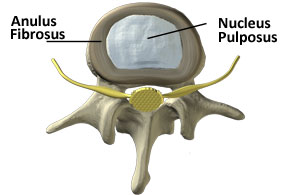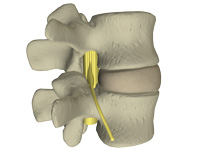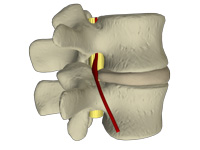
The
normal intervertebral disc is made of two parts: the outer anulus fibrosus and the inner nucleus pulposus. The inner nucleus pulposus contains a chemical named
glycosaminoglycan, and this chemical is the building block of the cartilage of the disc. Glycosaminoglycan has the ability to absorb water to 9 times its own volume, thus making
the disc a very fluid-filled substance.
 This fluid content also gives the disc the property of turgor, or intradiscal pressure, that holds the vertebrae (the bones of the spine) apart and allows movement of the spine.
This fluid content also gives the disc the property of turgor, or intradiscal pressure, that holds the vertebrae (the bones of the spine) apart and allows movement of the spine.
How Does Nutrition Affect Disc Degeneration And Herniation?
The health of the intervertebral disc is linked to its nutritional state. There is a decrease of important chemical substances like glycosaminoglyan and chondroitin within the disc as it loses water and becomes dehydrated. This decrease is called disc degeneration and is linked to loss of the disc height, instability, arthritis of the spinal joints, and spinal stenosis. Williamson disc degeneration will be experienced by many people.
Degeneration and Aging

We in Williamson can all look forward to aging. Can you guess what happens as we age, or injure our discs in the spine? Correct. The discs lose the chemical called glycosaminoglycan. The disc material
loses water content and shrinks. These changes in the disc become potentially painful. We also lose overall height due to a loss of the individual disc height; we
lose mobility and become
less flexible as the
disc dehydrates and narrows. We call this process of losing fluid and height of the disc "
degeneration". We all develop it to some degree with aging, just as we lose our hair, get wrinkles, and develop arthritis.
Contributing Factors to Degeneration: Limited Nutrition of the Disc and Mechanical Stimuli
- Studying the discs in sheep which were nutritionally well-fed or underfed for 7 days as well as stimulated with vibrational loading, researchers hypothesized that poor nutrition is even more influential in degeneration when outside stimuli are involved. (3)
- Researchers define disc degeneration as an active, irregular, cell-involved response to progressive structural failure due to aging and other environmental factors such as abnormal mechanical stress rather than a passive process of wear and tear. To stop or reverse disc degeneration, the abnormal conditions affecting cell development and maintenance must be addressed. When trying to repair or regenerate degenerated discs, both nutritional and biomechanical factors need to be corrected. The onset of human disc degeneration is reported to occur as early as the adolescent years, so very early intervention like nutrition is indicated. (4)
Nutrition and The Disc
In Williamson, what can we do to counteract these degenerative changes and maintain the most healthy spine possible? Can nutrition of the disc be affected? Consider this documented research report about nutrition and the disc and how nutrition can affect degeneration and actually maintain spine health and mobility:
- The nutrition of the disc is important as poor blood flow and nutrients to the spinal disc is a cause of disc degeneration and herniation. Disc nutrient concentrations could fall to levels inadequate to maintain cellular activity or viability, resulting in cell death and disc degeneration. (1)
There is research showing that intervertebral disc cartilage, like cartilage in other parts of the body such as the knee, can stop degenerating and even regenerate.
Nutrition and Cartilage: The Benefits Of Chondroitin Sulfate On Back And Joint Pain And Protection Of The Disc Cartilage
- One gram of chondroitin sulfate (known as the drug, "structum," in Russia) was given once a day for 24 weeks:
- 30 patients with low back pain (mean age 51)
- 73% of patients showed pain relief and improved spinal function
- Included in treatment of low back pain as chondroprotective drug (5)
- Osteoarthritis of the knees showed greatest potential for modification by glucosamine and/or chondroitin sulfate as seen by joint space width increase. (6)
- Glucosamine sulfate (but not glucosamine hydrochloride) and chondroitin sulfate have small to moderate symptomatic efficacy in osteoarthritis, although this is still debated. There is compelling evidence that glucosamine and chondroitin sulfate may interfere with progression of osteoarthritis. (7)
- Long-term use of chondroitin sulfate combines structure-modifying and symptom-modifying effects on osteoarthritis progression prevention and suggests it could be a disease-modifying agent in patients with knee arthritis. (8)
Reversing Disc Degeneration With Distraction Or Stretching Of The Spine
What about combining nutrition with spinal distraction? Can the positive effects of spinal nutrition be enhanced? Let's consider some papers on the effect of distraction stretching of the spine as is similarly performed with Cox® Technic Flexion Distraction and Decompression spinal manipulation and disc nutrition.
A benefit of Cox® Technic flexion distraction and decompression spinal manipulation is explained by the research study of Guehring (1) which shows that distraction reverses disc degeneration:
- 28 days of compression in rabbit disc caused degeneration via MRI study.
- 28 days of distraction regenerated the disc.
- Distraction results in disc rehydration, stimulated extracellular matrix gene expression, and increased numbers of cells.
- Disc distraction enhances hydration in the degenerated disc and may also improve disc nutrition via the endplates.
- Impaired nutrition leads to disc degeneration. Therefore, there is a definite need to improve disc nutrition. (2)
In Williamson, Discuss Stopping and Maybe Even Reversing Disc Degeneration with Your Chiropractor at Apple Country Chiropractic
Nutritional supplements and exercise of the spine may be recommended for your spine's care. These are intended to improve nutrition to the disc. Exercise stimulates circulation to the intervertebral disc to carry the necessary nutritional elements to it to stimulate regeneration.
Your Williamson chiropractor will likely discuss nutrition for treating your spinal condition. One product named Discat Plus provides chondroitin sulfate and glucosamine. This formula also contains minerals found in the intervertebral disc as well as perna canaliculus which is the highest source of chondroitin available today. It comes from a green lipped mussel from Australia. Similar formulations are on the market as well. For more detailed information on disc nutrition, please click here.
Be sure to discuss your choice of disc cartilage supplement with your chiropractor at Apple Country Chiropractic in Williamson to be sure you are getting the best quality for your degenerative disc and degenerative cartilage condition. Contact us today.
References
- Shirazi-Adl, A; Taheri, M; Urban, JPG. Analysis of cell viability in intervertebral disc: Effect of endplate permeability on cell population. Journal Of Biomechanics 2010;43 (7):1330-1336
- Guehring T, Omlor GW, Lorenz H, Engelleiter K, Richter W, Carstens C, Kroeber M: Disc Distraction Shows Evidence of Regenerative Potential in Degenerated Intervertebral Discs as Evaluated by Protein Expression, Magnetic Resonance Imaging, and Messenger Ribonucleic Acid Expression Analysis. Spine 2006; 31(15):1658-1665
- Illien-Jünger S, Gantenbein-Ritter B, Grad S, Lezuo P, Ferguson S, Alini M, Ito K: The Combined Effects of Limited Nutrition and High-Frequency Loading on Intervertebral Discs With Endplates. Spine 2010; 35(19):1744-1752
- Zhao, CQ; Wang, LM; Jiang, LS; Dai, LY. The cell biology of intervertebral disc aging and degeneration. Ageing Research Reviews 2007;6 (3):247-261
- Shostak NA et al: Low back pain in spinal osteochondrosis: experience of treatment with chondroprotective drug (article Russian). Terapevtichjeskii Arkhiv 2002; 74(8): 67-69
- Sawitzke, AD et al: Clinical efficacy and safety of glucosamine, chondroitin sulphate, their combination, celecoxib or placebo taken to treat osteoarthritis of the knee: 2-year results from GAIT. Ann Rheum Dis 2010; 69(8):1459-64
- Bruyere O, Reginster JY: Glucosamine and chrondrotin sulfate as therapeutic agents for knee and hip osteoarthritis. Drugs Aging 2007;24(7):573-80
- Hochberg MC, Clegg DO: Potential effects of chondroitin sulfate on joint swelling: a GAIT report. Arthritis Rheum 2009 Feb;60(2):524-33